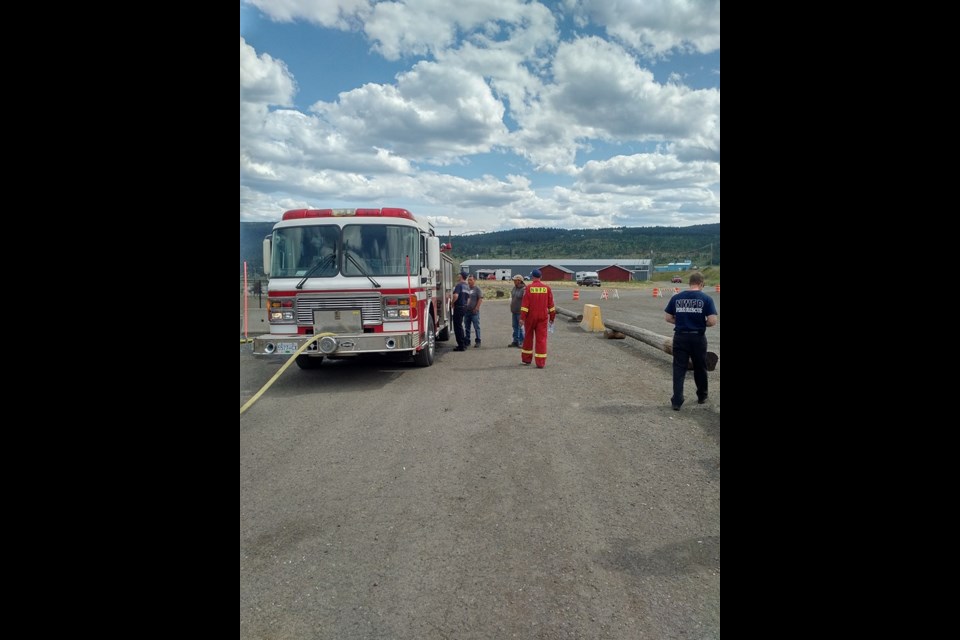A fire truck from the Royal City helped the Tl’etinqox First Nation defend its Anaham reserve from flames on the weekend.
Rather than disposing of a 15-year-old fire truck at auction, the City of New Westminster agreed to donate the vehicle that was being taken out of service to the Tl’etinqox First Nation. As luck would have it, a crew of local firefighters who had travelled to Williams Lake to fight forest fires were able to help train the Tl’etinqox First Nation how to use the fire truck and all its equipment.
“They were all excited,” Coun. Chuck Puchmayr said of the community’s response to its arrival. “They took pictures when it came in. They are just thrilled.”
Long before wild fires starting burning across B.C., the City of New Westminster agreed to send the fire truck to the reserve in Anaham. Tl’etinqox Chief Joe Alphonse told Puchmayr the truck would be appreciated as the community has to rent a fire truck when holding powwows and other events on their land in remote areas.
While it wasn’t clear whether the fire truck would be needed to fight forest fires, it was called into action on the weekend when “all hell broke loose” in Anaham.
“The fire came over the mountain and started heading straight for the reservation,” said Puchmayr, who accompanied the fire truck on its voyage to Anaham. “We just got the fire truck hooked up in time and were able to put out a couple of spot fires along the road. The fire burned all the way up to a fire guard that they made and then it was diverted. The wind took it downriver. The fire truck was a real asset to them.”
Because the fire truck runs on hydrants, it is available for use in the town in B.C.’s Central Interior.
Before accompanying the truck on its voyage, Puchmayr expressed some trepidation that the truck would give residents, who opted not to evacuate and to stay on their land, a false sense of security and put them at increased risk. Once there, he saw firsthand that the community is well trained, well supplied and has a good plan of attack.
Puchmayr told the Record Monday morning that there is still a “huge threat” to the community of Anaham. On the weekend, elders and children relocated to Redstone, a First Nations reserve about 30 kilometres away from Anaham.
“There is smoke in the whole area. If you have respiratory concerns or have children or are elderly, it would be advisable to get out of there,” Puchmayr said. “They really want to stay with their homes. Who knows? Someday that could become a risk factor. It is an area that is really complicated and has fire going on three sides of it, quite close. A lot of it will be dependent on the winds and some good luck.”
According to Puchmayr, the fires are “running wild” and are zero per cent contained in Anaham. He firmly believes that Chief Alphonse’s decision not to evacuate earlier resulted in the deployment of additional firefighting resources to the community.
“I predict that community would have been impacted by fire,” he said. “There would have been no one making those fire guards, there would have been nobody putting out the spot fires.”
Instead of putting the fire truck up for auction, where it likely would be bought by the film industry or scrap dealers for a few thousand dollars, Puchmayr said council agreed to donate the vehicle to the Tl’etinqox First Nation.
“They have huge value to small communities and First Nations and they have limited value as a commodity for recycling,” Puchmayr said. “I have talked to other local governments and said you guys should look at this and see if there’s a way you can give good rural resources stuff that isn’t applied here anymore.”
At 15 years in age, Puchmayr said the fire truck isn’t suitable for use in New West because of the amount of use it would get in the city, but it’s still a valuable asset to a smaller community where it’s used less often.
“It’s still in good shape. At that age, you start to have mechanical issues that happen, breakdowns, so they are not really good for that kind of (city) response,” he said. “They are excellent for a volunteer hall or something where there is more limited need.



